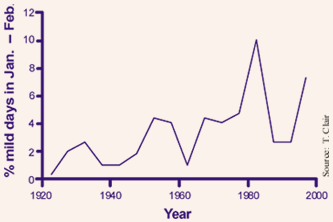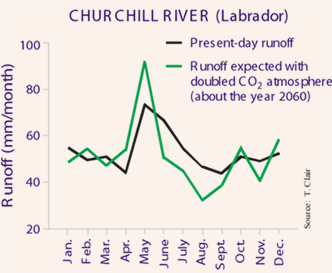| ||||||||||||||||||||||||||||
Proactive disclosure Print version |  The tides of change: Climate change in Atlantic Canada Freshwater issues Predicted changes in Hydrology Labrador - Less runoff, highest flows earlier than present, reduced flows in the summer Island of Newfoundland, Prince Edward Island, Nova Scotia, New Brunswick - More runoff, highest flows earlier than present (April rather than May), Summer flows less than present and earlier. The Saint John River: a glimpse of the future?
The number of mild days in January has been increasing...  Very large peak flows in late winter are becoming more frequent... 
If the current warming trend continues, there will be more frequent and unpredictable break up of ice on the river, and flooding. This will change patterns of damage to property, highways, and bridges. This also would force power companies to change management regimes of their reservoirs. Did you know? Churchill Falls (Labrador)
Labrador's Churchill Falls has been harnessed to provide hydro-electricity. Electricity is used by distant cities whose power requirements are greater in summer than in winter. 
With climate change, the Churchill River will likely have a higher spring flow than today. Turbines will be unable to deal with the high spring flow, and water will have to be spilled from the reservoir. Consequently, there will be less water in the summer, when there is the greatest market demand because the need for air conditioning in the U.S.A. This will reduce income from electricity sales.
|